What is employee experience?
From the moment prospective employees look at your job opening, to the moment they leave your company, everything that the workers learn, do, see, and feel contributes to their employee experience. For your organization to master employee experience management, you must listen to your people at each stage of the employee lifecycle, identify what matters most to them, and create personalized, bespoke experiences.
The employee experience is foundational to business performance. Sustaining customer experience efforts, improving products, and building a strong and reputable brand all require the help of your employees. Ultimately, it is their experiences – positive and negative – that will impact how hard they work, how much they collaborate, or whether they are invested in improving operational performance.
In a world where money is no longer the primary motivating factor for employees, focusing on the employee experience is the most promising competitive advantage that organizations can create.
– Jacob Morgan, author of The Employee Experience Advantage
Discover the fundamentals of employee experience as explained by the XM Institute
The rise of employee experience
The shift from old-school employee engagement to the more holistic approach of employee experience has been driven by a number of factors – including social media, changing demographics, the pandemic, and more volatile economic conditions.
- Millennials, and increasingly Gen Z, want more opportunities to have their say and companies need to get a deeper understanding of groups who feel, think and behave differently to previous generations.
- The war for talent is fiercer than ever before – there are now more jobs and fewer candidates, and experiences are one of the last ways to differentiate yourself as an employer in the hiring process
- Organizations are changing faster than ever – digitization, disruption, hybrid working, and other economic forces are causing companies to shrink and expand more rapidly. You need to understand the impact this is having on your people more regularly than once a year.
- There’s an expectation for personalized employee experiences – employees now expect to be treated as a unique person, just like they are when they interact with leading B2C brands as a consumer.
- The explosion of social media and the potential for damaging reviews to go viral has meant workplaces have become more transparent to protect company and brand reputation.
By focusing on employee behaviors and improving the employee experience, the world’s leading brands have discovered that there are knock-on effects: not just to traditional HR metrics like turnover and absentee rates, but also on customer experience and overall profitability.
Free eBook: This year’s employee experience trends report
The business impact of employee experience
Good employees are your greatest investment, and they’re hard to find. When you’ve battled to attract and hire quality people, you don’t want to lose them. Employee churn eats into your HR team’s time and also your business’s bottom line. Investing in positive employee experience is crucial to creating an engaged workforce who wants to stay with you, and it’s an effective way of reducing staff turnover.
Companies that invest in employee experience are 4x more profitable than those that do not.
– Jacob Morgan
The organizations that invest most heavily in EX are found:
- 11.5x as often in Glassdoor’s Best Places to Work
- 4.4x as often in LinkedIn’s list of North America’s Most In-Demand Employers
- 2.1x as often on the Forbes list of the World’s Most Innovative Companies
- 2x as often in the American Customer Satisfaction Index
Source: Jacob Morgan
How to leverage employee experience to drive customer experience outcomes
As well as the above, it has been known for a long time that great employee experience is critical for delivering great customer experience, which leads to business success. Happy employees deliver great products, providing exceptional service that drives a brand’s reputation, which in turn attracts more happy employees.
Glassdoor research shows that there’s a clear correlation between employee experience and customer satisfaction. On average, a 1-point increase in Glassdoor company rating is associated with a 1.3 increase in customer satisfaction:
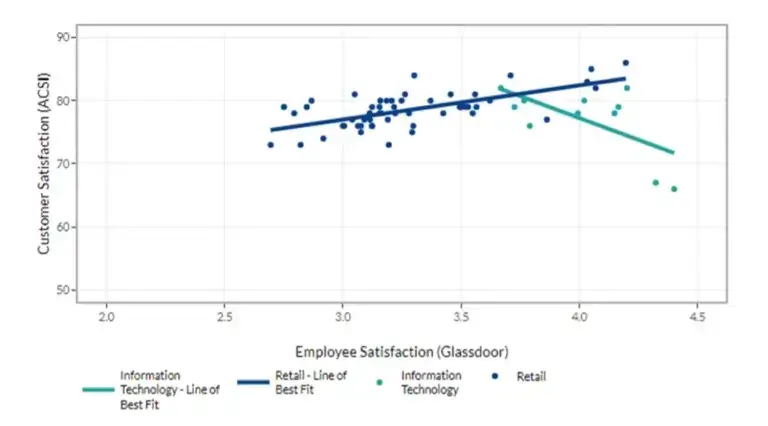
Glassdoor research
There are three consistent patterns in which frontline employee experiences are most strongly connected to customer experience outcomes:
- Expressing a connection with the organization’s vision, values, and purpose, or pride in the company’s products and services.
- Feeling safe, respected, cared for, and treated equitably.
- Being empowered, enabled, and rewarded for delivering great customer service.
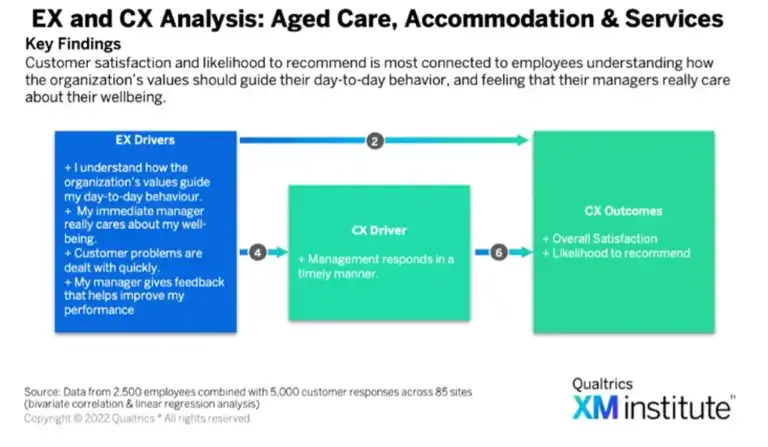
CX and EX analysis – XM Institute
Qualtrics has launched CrossXM, a new product that takes the hard work out of connecting your customer experience (CX) programs with your employee experience (EX) programs. You’ll be able to identify which employee experiences have the most (and the least) impact on the customer experience. Armed with this information, you’ll be able to plan, analyze, and monitor the impact of your employee experience initiatives.
Now it’s even easier to see how your employee, customer and brand experiences impact each other, so you can prioritize the actions that will have the biggest impact on your business.
Employee experience challenges in 2023
Clearly, creating a great employee experience is essential, but what are the challenges in getting it right in 2023?
Our research shows that there are four areas you need to focus on right now:
1. Instilling confidence that you’re sailing a successful ship
As the world and global markets become more volatile, it’s unsurprising that job security and financial certainty are employees’ top priority. All your employees need to know that they’re working for an organization that will continue being successful in the future, and pay them a competitive salary.
However, just over half (57%) of people surveyed are satisfied with their current pay and benefits, and that satisfaction has dropped 10 points since last year.
2. Employees have been working at surge levels for years. Now, they’re reclaiming boundaries
Going above and beyond used to be an exception, but recently it has become the expectation. Employers have leaned on employees throughout disruption. Now employees are pushing back and reshaping their relationship with work to set healthy boundaries and a better work-life balance.
Of those who feel they have a good work-life balance, almost two-thirds (63%) are willing to go above and beyond for their organization.
3. Bad processes and inefficient systems are fueling the risk of employee burnout
The past few years have completely scrambled how organizations operate: from how they hire and the tools they use, to remote work and the processes in place to get things done.
More than a third (38%) of employees feel they’re burnt out. The top driver of employee burnout this year is ineffective processes and systems – and organizations may be taking too long to resolve them.
4. Being employed isn’t just about having a job: it’s a part of a person’s value system
More and more employees want to work for organizations with integrity and purpose that matches their own, and at the same time, they crave growth and development opportunities that fulfill, challenge, and motivate them.
When employees feel that their organization embodies these values, they’re 27% more likely to have higher engagement scores, and 23% more likely to stay working for more than 3 years.
So how do you understand what your people want so that you can meet these current challenges head on? It all starts with listening:
Have a meaningful conversation about pay and benefits and how to meet employee expectations.
Avoid ‘job creep’ by ensuring equal and fair distribution of work-life balance and flexibility, and identify pain points or barriers to flexibility across your organization.
Ensure your people have the resources they need and that you take care of their mental and physical well being. Keep up with innovation and upgrade work processes to streamline activities and combat the risk of burnout.
Make the ‘company values’ conversation more prominent — take it seriously and encourage your most senior people to do so, especially leaders and other departmental role models. Create a culture of end-to-end feedback to help employees develop.
Of course, to address all of these points it’s important to understand every stage of the employee experience — and that’s what we’re going to cover next.
Employee experience stages
Employee experience equals everything a worker learns, does, sees and feels at each stage of the employee lifecycle.
The 5 stages of employee experience
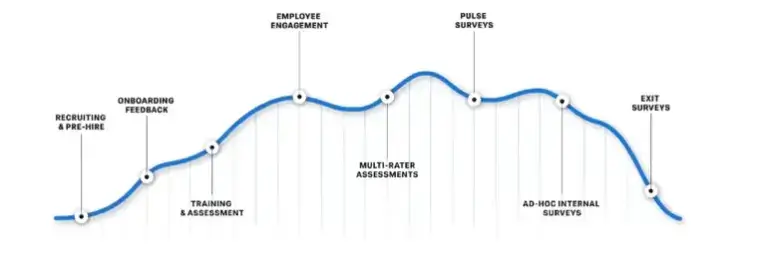
| Recruitment | This includes all the steps that lead to hiring a new employee. Considerations are how long it takes to hire, how much it costs to hire, the rate of offer acceptance, and the hire’s quality. Were your job ads attractive and clear enough to catch the attention and applications of the best candidates? Did your interview process engage and reassure great candidates so they quickly accepted your job offer? How was the entire candidate experience? |
| Onboarding | A new hire gets up to speed with the systems, tools, and processes and comes to grips with the role’s expectations. Most new employees need “ramp time” to get up to speed and become productive in their job. Obviously, the quicker they can do this, the more profitable it is for your organization. An effective onboarding process translates someone’s initial enthusiasm for their new job into a more meaningful, long-term connection to the brand and a commitment to doing great things while they’re there. |
| Development | Employee development is an ongoing stage in the employee journey, with individuals developing at different rates across a variety of skills. As employees develop within their roles, you need to quantify their productivity, ability to be a team player, and promotion aspirations. You also want to offer them the chance to expand their skill sets, an increasingly important differentiator for many employees looking to have a “portfolio career” consisting of many different experiences. |
| Retention | Employees are now fully ramped and integrated into the organization. With a strong people retention strategy, you can keep them performing, developing, and contributing to the company’s success, as well as ensure they’re inspired by and connected to the company’s core vision. It makes economic sense for a company to do all it can to keep hold of existing employees. It can cost up to 50%-60% of an employee’s annual salary to replace them. |
| Exit | Employees can leave for a whole host of reasons: They may retire, move to another employer, or make a life change. Every employee will leave your company at some point, and finding out why is an opportunity to improve and develop the employee experience for current and future employees. Leavers may be more candid in exit interviews about why they’re going as they may feel they have nothing to lose by being brutally honest. |
The ‘3 environments’ of employee experience
As a new hire travels along their employee journey to their eventual exit from your organization, there are a few things that will shape their employee experience. Jacob Morgan, author of The Employee Experience Advantage, highlights three basic environments, no matter how large or small your organization, that make up employee experience:
1. Company culture
Difficult to define as each one is different, a company’s culture may be what the C-suite tells you it is, what you understand of its mission, values, practices and attitudes, or even the shop-floor camaraderie when senior management isn’t in. It’s a mixture of leadership style and organizational structure, sense of purpose and the mixture of personalities who work with you. Corporate culture is the vibe that you feel when you come into work – it can motivate or stifle, energize or drain, empower or discourage its employees.
2. Technology environment
Imagine firing up a desktop computer on your first day and discovering you’ll be working on Windows XP. Forward-thinking organizations invest in suitable tools for employees to get their work done efficiently, with future developments in mind. The technology landscape is so vast, that it’s easier than ever to give employees the tools they need to maximize their efficiency and make them feel more confident in their role.
3. Workplace environment
Employees who work 9 to 5 in a windowless, air-conditioned basement will have a very different experience from those who work flex-time in an airy new glass building with an on-site gym, subsidized canteen, chill-out lounges, and wellness programs. Employees who are happy in their work environment will concentrate better, have improved well-being, and will be more productive. And the physical space is not necessarily always in the office: Autonomy to work from home or in multiple workspaces can also contribute to a positive employee experience.
Free eBook: This year’s employee experience trends report
How to improve employee experience
If you only focus on employee engagement and company culture, you’re missing the trick of integrating all your workplace, HR, and management practices to focus on the employee experience.
As you set out to improve the employee experience and the three basic environments listed above, here are some other things to consider:
Hire a Chief Experience Officer (CXO)
With companies realizing that improved employee experience leads to increased customer loyalty, profitability, and revenues, there’s a new kid on many C-suite blocks along with the CEO, CFO, CMO, CIO, and COO – the CXO (Chief Experience Officer).
CXOs take ownership of all aspects of employee experience: employee engagement, employee satisfaction, performance management, career development, employee recognition, talent management, and keeping most employees happy, whether they are remote workers or onsite.
CXOs bring their employee experience framework to the executive table alongside finance, IT, operations, human resources, and marketing. Reports to the CXO include EX managers who deliver on the strategy across the organization.
The CXO role ensures that employee feedback is acted upon, and that any changes are communicated to employees effectively. This is fundamental to a positive employee experience, as demonstrating action creates a cycle whereby employees are more likely to be engaged and deliver feedback.
Combine your O- and X-Data
You’ll gather an enormous amount of O-data (operational data) from an employee throughout their time with you – from basic personal details, to training they’ve received and their salary history. Combine that with X-data – what that employee tells you about their experience – and you will unlock greater insight into why things are happening in your company and what you can do better.
For example: O-data tells you to spend money on employee perks; X-data tells you whether your employees like those perks and what they’d prefer instead.
Enlist C-suite and leadership support
Research shows the connection between EX and business outcomes. Your organization’s business leaders will want to see a direct link to business key performance indicators (KPIs), such as increased productivity, greater employee retention, company reputation, excellent scores, and a healthy return on investment. Excellent employee experience delivers all these. Capturing these results in easy-to-understand dashboards and reports gets your most important stakeholders on your side.
Designate ownership to a senior leader or team
Senior HR leaders, such as learning and development directors and recruitment directors, are the natural choice to own your program and report its data and actions to the CXO and executive team. Work with them so they understand their responsibilities and the actions you intend to take when the data is in. However, keep in mind that every leader in your organization will play a role in building exceptional employee experiences. Encourage business leaders across the organization to implement the Five I’s of Employee Engagement – inform, inspire, instruct, involve, and incent.
Listen to all your employees!
Learn about what your employees are doing every day. Trial new ways of simplifying work and improving productivity and performance, making every event along their lifecycle engaging, meaningful, and personal. Where your company is international, understand that different cultures will have different views and opinions.
Be prepared to invest in the work environment
Redecorated, light premises; autonomy to work from home; fresh new furniture and tech; real coffee on tap; space and permission to take time out to be creative or make their own customer service decisions; even an office dog. Offer the things that make your employees want to come into work. When you make a habit of asking them what they want through surveys, they’ll tell you.
Measure it
Replace annual or biannual employee engagement surveys with regular pulse surveys and open feedback platforms. Include candidate interviews, engagement surveys, ongoing performance conversations, annual performance reviews, and exit interviews to gather real-time understanding of the issues your employees face.
Instead of chasing a metric, remember to keep the focus on EX improvements and better business outcomes. Always ask two questions whenever you’re reviewing results:
- What did we learn?
- What improvements are we making?
I’ve put the content from ‘Employee experience jobs’ here – it sits better
Our insights into the employee experience have moved on leaps and bounds – we can now give leaders the actions they need to focus on to have an impact on their teams.
– Carl Tabisz, Senior Engagement Manager, Asda
How to design your employee experience strategy
When you consider that employee experience is ultimately about creating personalized experiences, developing an employee experience framework is a challenge – especially in the face of constant change. Yet if you embrace a growth, rather than fixed mindset. and break down your EX strategy into three basic elements, you’ll be able to design and shape a compelling employee experience for your workforce:
- Discover the moments that matter to your employees by collecting regular feedback from across the employee lifecycle
- Make company culture, technology and the physical workplace the best they can be
- Broaden your traditional HR team functions to recognize the importance of customer experience and how employee experience impacts it
No company, small or large, can win over the long run without energized employees who believe in the mission and understand how to achieve it.
– Jack Welch, former CEO of GE
Now that you know how to design your employee experience strategy, what tools and technologies do you need to make it a reality? Let’s take a look.
Employee experience workplace technology
These days, you cannot have an employee experience strategy without employee experience technologies. In fact, setting up the technology should be a priority: you need to hear every voice in your organization, whether it’s in the office, on job sites, or remote.
You’ll need a single, all-encompassing listening engine with tools to help you understand and design the unique employee experiences your diverse workforce requires, to ensure you can take action when and where it matters most, across every touchpoint.
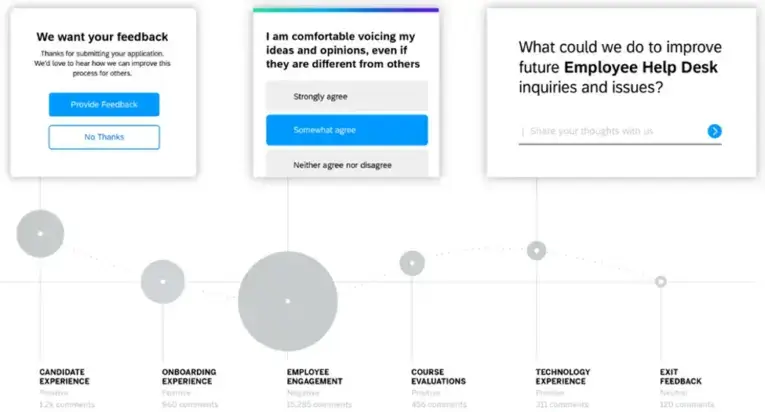
Employee listening engine
For a comprehensive end-to-end employee experience, this engine must include:
Listening tools
Instead of asking for feedback, listen for it all the time, across an incredible array of channels. A listening engine that applies artificial intelligence and machine learning to engagement responses in real-time can analyze:
- Customer comments in recorded video feedback
- voice calls in customer care centers
- Conversations in SMS and chat applications
- Website and app feedback
- Employee feedback in collaboration tools, e.g. Microsoft Teams and Slack
- Feedback on company review sites
- Social media sentiment
- Feedback from any internet-connected smart device
Check out Qualtrics Employee Engagement to see how you can level up your listening strategy.
Predictive analytics
AI-driven analytics and advanced statistical and human language tools automatically model your experience and operational data 24/7 to identify key areas of focus.
These tools help you to uncover insights deep from within your employee feedback system, spotting trends in open-text feedback with sentiment and topic analysis.
Automated actions and workflows
Automated actions and real-time workflows for frontline managers, with feedback-to-action loops for every employee experience.
With automated actions and workflows, you can go from insight to action and start closing gaps across your organization.
DEI capabilities
Design your culture of belonging and create an empowering experience for all your people. Enable leaders to easily view the most impactful actions they need to close DEI gaps.
With the right DEI solution, you can use research-backed methodologies and purpose-built tools to drive meaningful change at scale.
Onboarding optimization
Build the foundation for successful teams with onboarding surveys and insights that decrease ramp time, boost productivity and drive early engagement among your new employees.
Using tools like Qualtrics Candidate Experience, you can turn onboarding and candidate engagement into your competitive advantage. You can design and improve the overall experience, as well as grow your talent pipeline, reduce costs, streamline processes and much more.
Exit interview diagnostics
With real-time exit insights, you’ll understand why your top performers leave, and drive actions across the organization to retain your top talent and build a happier, more engaged workforce.
You can also monitor the impact of the changes you make to increase retention — from how those changes influence engagement to the benefits they have on your organization’s bottom line.
Employee surveys
Still the most trusted and secure way to collect feedback at scale. Employee surveys allow you to tap into the thoughts and feelings of your workforce and discover what they value most. Once you understand what drives and engages them, you can start to develop people-centric strategies that improve retention, well-being, inclusion, productivity and satisfaction, helping to push your organization forward.
Below we’ll highlight some of the most vital types of employee experience surveys you need as part of your experience management toolset.
Free eBook: This year’s employee experience trends report
Types of employee experience surveys
To deliver personalized experiences, it’s crucial you understand how employees feel at different stages of their employee lifecycle: when they join you, as they develop, and as they leave. What experiences have been positive, and where could you, as a company, make improvements?
An employee experience management program should incorporate different types of listening elements to measure employee engagement and experiences at key moments in the lifecycle. To gain a deeper understanding of how your employees feel, your listening program must generate feedback on a regular basis.
For example, pulse surveys capture a regular, structured measurement of employee attitudes, and ad-hoc surveys collect just-in-time feedback on things like organizational changes, new programs or policies, or corporate initiatives.
Engagement surveys
Employee engagement is a measure of someone’s connection to their work and how they think, feel, and act toward helping their organization meet its goals. These reviews – typically conducted annually – are particularly useful at the retention stage of the employee lifecycle, as they indicate how involved and engaged established employees feel in their work.
Employee engagement has an impact across the business:
- Increased performance – Research shows that business unit-level engagement is predictive of future customer experience metrics, productivity, and financial performance
- Lower attrition – Engaged employees are 87% less likely to leave their organization, which means reduced costs in having to recruit new staff, train them and wait for them to ramp up to full productivity
- Increased revenue – According to Bain & Company, companies with highly engaged workers grew revenues 2.5x as much as those with low levels of engagement
- A better customer experience – 70% of engaged employees indicate they have a good understanding of how to meet customer needs; only 17% of non-engaged employees say the same
Candidate reaction surveys
Candidate reaction surveys evaluate your company’s ad-to-hire process for new employees. A good survey will capture the experiences of both successful and unsuccessful candidates, making everyone feel that they matter and their voices are heard, whatever the outcome. It’ll reveal the effectiveness of your reach with advertising and marketing, brand, and recruitment processes. And treating unsuccessful candidates well enhances company reputation by creating advocates who had a positive experience with you.
Check out our free candidate experience survey template today.
Onboarding surveys
Onboarding introduces a new hire to their colleagues, their role, expectations, and available resources and embeds them into your company culture. It’s important to find out what your new hires think of their “ramp time” by using onboarding surveys. Gather first impressions from day one, then regularly perform surveys once new hires have had a chance to settle in and form their opinions. The onboarding experience sets the tone for the whole employee journey, and it’s strongly linked with important employee experience and engagement KPIs.
Training feedback surveys
Training sessions are crucial to a successful onboarding process, but they’re also important milestones during the development and retention stages. Gathering data before and after every training event during the lifecycle will map an individual’s growth and highlight where the organization could enhance learning and development more efficiently.
Performance reviews
More regular reviews – pulse surveys every three to six months – and “performance management conversations” with managers are becoming the new normal. Specific metrics could be included in performance review feedback, or the focus could be on developing “soft skills” like how an employee interacts with colleagues.
360 reviews
Manager and employee performance reviews can reveal only part of the picture of how an employee functions in your organization. Also known as multi-rater feedback assessments, 360 reviews include appraisals by a senior, a junior, and a peer, as well as a self-assessment. Because they’re anonymous, 360 reviewers are more likely to say what they really think. That said, they are best used only for team and professional development, not to rate and reward individual performance.
Exit surveys
You’ll probably get your most honest feedback at the exit interview. It’s an ideal opportunity to ask those questions that your organization most needs answers to, particularly where staff turnover is high. You’ll be able to understand your attrition rate better when you can link exit surveys with your other lifecycle surveys such as 360 reviews and employee engagement.
Pay and benefits optimization surveys
In a Glassdoor survey, 60% of employees said that benefits were a major factor when weighing a new job offer. And 80% of employees would choose better perks over a pay raise. Using pay and benefits surveys, you can find out what your employees really want and analyze their responses to create a benefits package that helps you attract and retain talent, while optimizing your overall spend.
Always on surveys
There’s a growing trend for daily surveys that include a handful of very simple questions about how employees are feeling. By providing an on-demand, anonymous channel for employees to provide feedback, offer insights, and raise issues, you can capture a real-time snapshot of company morale and employee satisfaction. For example, if morale seems low one day, this could mean a change in tone from business leadership communications.
Skills for employee experience professionals
Including the tools outlined in this article, it’s important to invest in the right skills to ensure your people leaders maximize their capabilities.
Employee experience management is part of the larger discipline of Experience Management (XM) that aims to improve the fore core experiences of a business: customer, employee, product, and brand.
To master employee experience management, companies should adopt the XM Operating Framework, which is built on a combination of technology, culture, and six competencies. Within each competency are three to four skills that you must master to realize the value of XM.
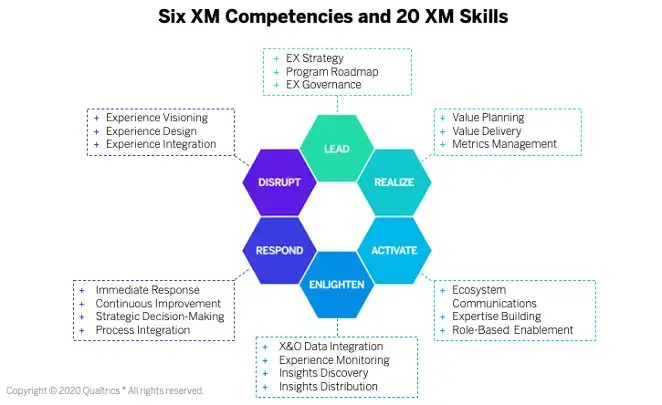
XM Core Competencies – XM Institute
To get started, you need to understand your organization’s strengths and weaknesses. Use the XM Institute’s Employee Experience Maturity Assessment to evaluate where you sit now, and then use it every six to 12 months to see how you are improving within the six XM competencies and evolving through the five stages of EX maturity.
For us, the focus around employee experience is on creating a seamless experience around the things somebody needs to do as an employee while allowing them to focus on the business we hired them for—development, sales, leading new products [and so on]. We’ve actually created a VP level role to strictly focus on the employee experience.
– Adam Khraling, VP of Global HRIS, American Express
The recent upheavals and changes in business, economy, and society are unprecedented. What’s clear is that employee experience directly affects how your business navigates change, disruptions, and economic volatility. Great employee experience, as we’ve seen, has a positive impact on your whole business, from recruiting new hires to delivering profit. Investing in EX roles, departments, and technology to join the dots between employee engagement and business performance has never been money better spent. If you’re looking for an all-in-one solution to help you navigate employee experience and deliver precisely what your people expect of your organization, look no further than the Qualtrics Employee Experience platform. It’s the solution every organization needs to deliver more human-centric experiences.
Free eBook: This year's employee experience trends report